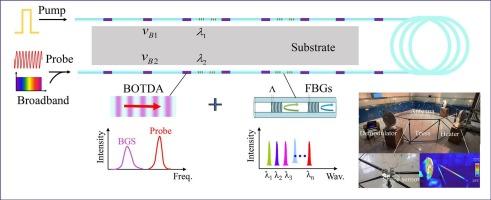Temperature-insensitive shape sensor for realtime deformation monitoring of discontinuous spaceborne antenna truss
IF 5.6
2区 工程技术
Q1 ENGINEERING, MULTIDISCIPLINARY
引用次数: 0
Abstract
Space-borne deployable antennas are evolving towards larger aperture and higher precision, aiming to achieve high-resolution detection of weak electromagnetic targets. Random and uncertain structural deformations often occur in such discontinuous structure containing kinematic pairs due to the unstable motion of mechanism caused by kinematic pair clearances and on-orbit environment, which are hard to be theoretically predicted. In this study, Brillouin optical time domain analysis-fiber Bragg gratings optically fused high-resolution shape sensor assisted with a transfer learning-assisted error online prediction model was proposed and demonstrated for space-borne antenna truss monitoring. The shape sensor exhibited highly flexible, temperature/ axial stretching/ axial compression insensitive, and calibration-free characteristics. The shape reconstruction error from discrete curvatures was online predicted from the perspective of transfer learning, which addressed the challenge of reconstruction error varying from geometric shape and reconstruction distance. The overall shape deviation was decreased by 53.4 %. The effectiveness and accuracy of the proposed deformation monitoring method was demonstrated by a dodecagonal circular antenna truss under non-uniform temperature environment, and achieved a measurement accuracy of 94.8 % and 96.0 % for 9.2 m distance under two conditions compared to the applied maximum deformations. The unique displacement transfer characteristics in clearances-containing discontinuous structures were detected for the first time, which will provide a novel means and new sight into kinematic mechanism understanding and closed-loop control of deployable antennas, soft robots and artificial muscles.

用于非连续星载天线桁架实时变形监测的温度不敏感形状传感器
星载可展开天线正朝着更大孔径、更高精度的方向发展,旨在实现对弱电磁目标的高分辨率探测。由于运动副间隙和在轨环境导致机构运动不稳定,这种包含运动副的不连续结构往往会发生随机和不确定的结构变形,难以从理论上进行预测。在这项研究中,提出并演示了基于迁移学习辅助误差在线预测模型的布里渊光时域分析-光纤布拉格光栅光融合高分辨率形状传感器用于星载天线桁架监测。该形状传感器具有高度柔性、温度/轴向拉伸/轴向压缩不敏感以及无需校准的特性。从迁移学习的角度在线预测离散曲率的形状重构误差,解决了几何形状和重构距离随重构误差变化的问题。整体形状偏差降低53.4%。以非均匀温度环境下的十二角圆形天线桁架为例,验证了所提出的变形监测方法的有效性和准确性,在两种条件下,与应用的最大变形相比,在9.2 m距离上的测量精度分别达到了94.8%和96.0%。首次发现了含间隙不连续结构中独特的位移传递特性,这将为可展开天线、软体机器人和人造肌肉的运动机理理解和闭环控制提供新的手段和视角。
本文章由计算机程序翻译,如有差异,请以英文原文为准。
求助全文
约1分钟内获得全文
求助全文
来源期刊

Measurement
工程技术-工程:综合
CiteScore
10.20
自引率
12.50%
发文量
1589
审稿时长
12.1 months
期刊介绍:
Contributions are invited on novel achievements in all fields of measurement and instrumentation science and technology. Authors are encouraged to submit novel material, whose ultimate goal is an advancement in the state of the art of: measurement and metrology fundamentals, sensors, measurement instruments, measurement and estimation techniques, measurement data processing and fusion algorithms, evaluation procedures and methodologies for plants and industrial processes, performance analysis of systems, processes and algorithms, mathematical models for measurement-oriented purposes, distributed measurement systems in a connected world.
 求助内容:
求助内容: 应助结果提醒方式:
应助结果提醒方式:


